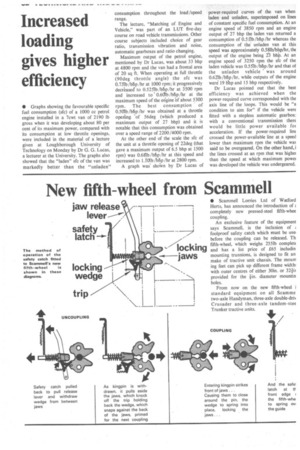Increased loading gives higher efficiency
Page 64

If you've noticed an error in this article please click here to report it so we can fix it.
• Graphs showing the favourable specific fuel consumption (sfc) of a 1000 cc petrol engine installed in a 7cwt van of 2190 lb gross when it was developing about 80 per cent of its maximum power, compared with its consumption at low throttle openings, were included in the material of a lecture given at Loughborough University of Technology on Monday by Dr G. G. Lucas, a lecturer at the University. The graphs also showed that the "laden" sfc of the van was markedly better than the "unladen" consumption throughout the load /speed range.
The lecture. "Matching of Engine and Vehicle," was part of an LUT five-day course on road vehicle transmissions. Other course subjects included choice of gear ratio, transmission vibration and noise, automatic gearboxes and ratio changing.
Maximum output of the petrol engine, mentioned by Dr Lucas, was about 33 bhp at 4800 rpm and the van had a frontal area of 20 sq ft. When operating at full throttle (90deg throttle angle) the sfc was 0.731b /bhp /hr at 1000 rpm; it progressively decreased to 0.5251b /bhp /hr at 3500 rpm and increased to 0.64111, /bfip/hr at the maximum speed of the etigine 'of about 5300 rpm. The best consumption of 0.50113/bfip/hr was obtained at a throttle opening of 56deg (which produced a maximum output of 27 bhp) and it is notable that this consumption was obtained over a speed range of 2200/4000 rpm.
At the other end of the scale the sfc of the unit at a throttle opening of 22deg (that gave a maximum output of 6.5 bhp at 1500 rpm) was 0.681b /bhp /hr at this speed and increased to 1.101b /bhp /hr at 2800 rpm.
A graph was shoWti by Dr Lucas of power-required curves of the van when laden and unladen, superimposed on lines of constant specific fuel consumption. At an engine speed of 3850 rpm and an engine output of 27 bhp the laden van returned a consumption of 0.511b /blip /hr whereas the consumption of the unladen van at this speed was approximately 0.581b/bhp/hr, the output of the engine being bh'p. At an engine speed of 3250 rpm the sfc of the laden vehicle was 0.55Ib /bfip/hr and that of the unladen vehicle was around 0.621b/blip/hr, while outputs of the engine were 1913hp and 15 bhp respectively.
Dr Lucas pointed out that the best efficiency was achieved when the power-required curve corresponded with the axis line of the loops. This would be "a condition to aim for" if the vehicle were fitted with a stepless automatic gearbox with a conventional transmission there would be little power available fo; acceleration. If the power-required line crossed the power-available line at a speed lower than maximum rpm the vehicle wat said to be overgeared. On the other hand, i the lines crossed at an rpm that was highe; than the speed at which maximum powei was developed the vehicle was undergeared.






































































































































































